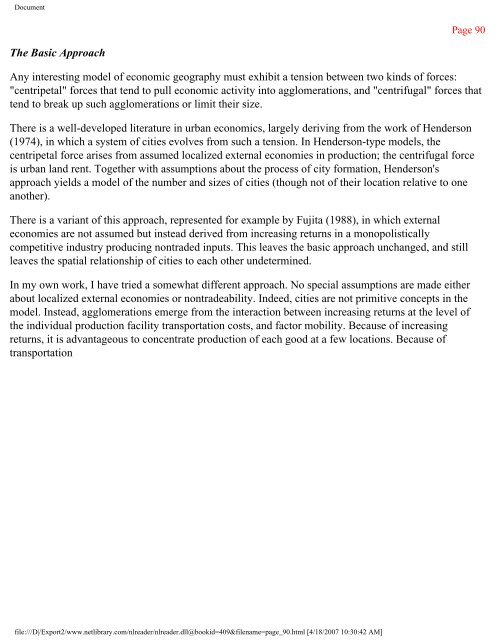Document file:///D|/Export1/www.netlibrary.com/nlreader/nlreader.dll ...
Document file:///D|/Export1/www.netlibrary.com/nlreader/nlreader.dll ...
Document file:///D|/Export1/www.netlibrary.com/nlreader/nlreader.dll ...
You also want an ePaper? Increase the reach of your titles
YUMPU automatically turns print PDFs into web optimized ePapers that Google loves.
<strong>Document</strong><br />
The Basic Approach<br />
Page 90<br />
Any interesting model of economic geography must exhibit a tension between two kinds of forces:<br />
"centripetal" forces that tend to pull economic activity into agglomerations, and "centrifugal" forces that<br />
tend to break up such agglomerations or limit their size.<br />
There is a well-developed literature in urban economics, largely deriving from the work of Henderson<br />
(1974), in which a system of cities evolves from such a tension. In Henderson-type models, the<br />
centripetal force arises from assumed localized external economies in production; the centrifugal force<br />
is urban land rent. Together with assumptions about the process of city formation, Henderson's<br />
approach yields a model of the number and sizes of cities (though not of their location relative to one<br />
another).<br />
There is a variant of this approach, represented for example by Fujita (1988), in which external<br />
economies are not assumed but instead derived from increasing returns in a monopolistically<br />
<strong>com</strong>petitive industry producing nontraded inputs. This leaves the basic approach unchanged, and still<br />
leaves the spatial relationship of cities to each other undetermined.<br />
In my own work, I have tried a somewhat different approach. No special assumptions are made either<br />
about localized external economies or nontradeability. Indeed, cities are not primitive concepts in the<br />
model. Instead, agglomerations emerge from the interaction between increasing returns at the level of<br />
the individual production facility transportation costs, and factor mobility. Because of increasing<br />
returns, it is advantageous to concentrate production of each good at a few locations. Because of<br />
transportation<br />
<strong>file</strong>:///<strong>D|</strong>/Export2/<strong>www</strong>.<strong>netlibrary</strong>.<strong>com</strong>/<strong>nlreader</strong>/<strong>nlreader</strong>.<strong>dll</strong>@bookid=409&<strong>file</strong>name=page_90.html [4/18/2007 10:30:42 AM]
















